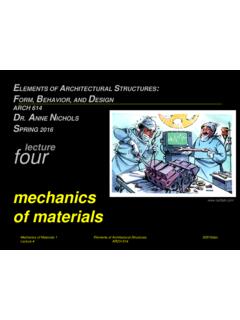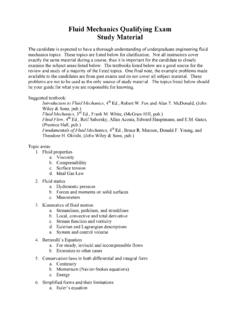Transcription of EMA 3702 Mechanics & Materials Science (Mechanics of ...
1 EMA 3702 Mechanics & Materials Science ( Mechanics of Materials ) Chapter 2 Stress & Strain - Axial Loading EMA 3702 Mechanics & Materials Science Zhe Cheng (2018) 2 Stress & Strain - Axial Loading Statics vs. Mechanics of Materials Statics - Deals with un-deformable bodies (rigid bodies) Mechanics of Materials - Deals with practical, deformable bodies Need to calculate the stress and deformation (relative and absolute) of a body under various loading (stress) states Compute forces and related information (stress/strain) for certain statically indeterminate problems Poisson 's Ratio When a material is subject to normal stress ( , tensile) in one direction, it subject to deformation in other (transverse) directions.
2 Define Poisson s Ratio v For isotropic material : Within elastic limit strain axialstrain lateral xzxy Exx Exzy Axial loading from more than one directions? Principle of Superposition: The combined effect (strain) = individual effect (strain) Multiaxial Loading Assumptions: Each effect is linear The deformation is small and does not change the overall condition of the body. Generalized Hooke's Law Normal strain along each direction (x, y, z) comes from three contributions: EEEzyxx EEEzyxy EEEzyxz EMA 3702 Mechanics & Materials Science Zhe Cheng (2018) 2 Stress & Strain - Axial Loading Class Exercise A 500 mm long, 8 mm diameter rod ( , cross-section area of ~50 mm2) made of homogeneous rod is subject to 10 kN axial tensile load.
3 The length increases by mm while the diameter shrinks by 2 m. Please calculate elastic modulus and Poisson s ratio. mmmmmmmmxy Elastic modulus E Poison ratio v Shearing Strain (1) For general loading condition, shearing stresses are present, the angle between neighboring surfaces of cube unit will change: From a cube oblique parallelepiped Shearing Strain (2) in radians The change in angle due to shearing stress (from /2) is defined as shearing strain Sign convention for shearing strain: If shear causes reduction in that angle, it is positive; otherwise, negative xy Hooke s Law for Shearing Within elastic (proportional) limit, xyxyG G is Shear Modulus or Modulus of Rigidity yzyzG xzxzG Generalized Hooke s Law Gxyxy Gyzyz Gxzxz Relationship between E, G, and 12 EGEEE zyxx EEEzyxy EEEzyxz EMA 3702 Mechanics & Materials Science Zhe Cheng (2018) 2 Stress & Strain - Axial Loading Class Exercise A 2 inch thick 2 8 in2 rectangular block with shear modulus G = 100 ksi is bonded between the rigid ground and one rigid top plate, as illustrated.
4 The top plate is subjected to shear force P. Knowing the top plate moved inch horizontally. Please calculate the average shearing strain and the shear force P. P 2 in Average shearing strain 2 in in Shear force P In case one wants to know the angle in deg, Stress-Strain Distribution: Ideal vs. Actual Idealized condition: Uniform stress distribution In reality: Non-uniform distribution Local stress changes in complex way APave EMA 3702 Mechanics & Materials Science Zhe Cheng (2018) 2 Stress & Strain - Axial Loading The stress distribution far away from the region where the load is applied is NOT related to the mode of application.
5 Implication: for axial loading, uniform stress if it is far away from loading points Saint-Venant's Principle Stress Concentrations (1) Stress rises at locations where geometric discontinuity exists Stress Concentration Factor The sharper the crack tip (or smaller r), the higher K aveK max Stress Concentrations (2) Stress rises at locations where geometric discontinuity exists The sharper the fillet (smaller r), the higher K The larger the dimension ratio (D/d), the higher K aveK max Plastic Deformation Idealized elastoplastic behavior: After linear elastic deformation, plastic deformation is characterized by no change in stress ( , flat line) until fracture or rupture.
6 Y A Y Rupture When ave = Y When max = Y When max < Y Stress Concentration Involving Plastic Deformation As load P increases aveK max AKAP avemax AKPYY APYU Yielding occurs Load for yielding: Elastic deformation (Ultimate) load for fracture: Fracture occurs (after certain deformation) Cube with unit length subject to multiaxial stress of x, y, z The total volume changes from 1 to : Dilation & Bulk Modulus (1) Neglecting the high order terms yields: Relative change in volume, also called dilation, e zyxe 1 From the relationships between i and i , we have zyxEe 21zyx 1)1)(1)(1(zyx Special case: Hydrostatic pressure or x = y = z = -p Define as bulk modulus or modulus of compression: Dilation & Bulk Modulus (2) Dilation zyxEe 21 pEe 213 213 E pe Practically, when applying pressure, volume should shrink or dilation e should be negative must be positive Therefore, (1 - 2 ) > 0 0 < < = 0 = Dilation & Bulk Modulus (3) 0213 EFor boundary conditions Epe3 3E 0 eIncompressible solid pe Dilation Residual Stresses After the applied load is removed, some stresses may still remain inside the material Example.
7 Solder a bar over a hole on a metal plate During cooling, metal bar gradually hardens and (tensile) stress develops within the bar, which may even exceeds yield strength! EMA 3702 Mechanics & Materials Science Zhe Cheng (2018) 2 Stress & Strain - Axial Loading Homework Read text book chapter sections to , (you may skip the sample problems) and give an honor statement confirm reading. EMA 3702 Mechanics & Materials Science Zhe Cheng (2018) 2 Stress & Strain - Axial Loading Homework A plastic wire is pulled by a tensile force of 4 N, and its length increases by 1%. If the plastic has elastic modulus of 4 GPa.
8 Please calculate (a) average normal stress in the wire and (b) the diameter of wire EMA 3702 Mechanics & Materials Science Zhe Cheng (2018) 2 Stress & Strain - Axial Loading Homework The 4 mm diameter metal wire EF has modulus E = 200 GPa. If the maximum stress should not be higher than 250 MPa, and the elongation of the wire should be longer than 5 mm. Please calculate the maximum load P can be applied. 2 m D F E F 2 m 3 m EMA 3702 Mechanics & Materials Science Zhe Cheng (2018) 2 Stress & Strain - Axial Loading Homework Members CD and BC have common E = 29 106 psi and cross-section area of in2 and in2, respectively.
9 For the forces shown, determine the elongation of (a) CD and (b) BC. 5 ft B 50 kips C A 5 ft 5 ft 25 kips D E EMA 3702 Mechanics & Materials Science Zhe Cheng (2018) 2 Stress & Strain - Axial Loading Homework A centric load of P=400 kN is applied to the composite block shown through a rigid end plate. The iron plate (GFe=200 GPa) is sandwiched between two Cu plates (GCu=80 GPa). Center iron plate is 40 mm thick while the outer Cu plates are 20 mm thick. All plates are 500 mm long and 100 mm wide, Calculate the normal stress in (a) the center Fe core and the outer Cu plates 40 mm 20 mm 20 mm 500mm 400 kN EMA 3702 Mechanics & Materials Science Zhe Cheng (2018) 2 Stress & Strain - Axial Loading Homework A rigid bar EH is supported by two steel wire of 1/16 in diameter (E=29 106 psi) and a pin and bracket at H.
10 Knowing that the wires were initially tight. Determine (a) the additional tension in each wire when a 220-lb load P is applied at E. (b) The corresponding deflection (downward displacement) of point E. 10 in 10 in 200 lb G F 10 in 10 in 8 in H E EMA 3702 Mechanics & Materials Science Zhe Cheng (2018) 2 Stress & Strain - Axial Loading Homework A tensile force of 2 kN is applied to a test steel (E = 200 GPa, = ) bar with rectangular cross-section with initial thickness of 2 mm, initial width of 10 mm, and initial length of 100 mm. Please calculate the absolute change in (a) sample length, (b) sample thickness, (c) sample width, and (d) sample cross-section area.










